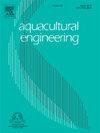Estimation of total suspended solids by settleable solids and turbidity, using coagulants and flocculants as settlers
IF 4.3
2区 农林科学
Q2 AGRICULTURAL ENGINEERING
引用次数: 0
Abstract
Accurate measurement of solids in different biofloc systems is essential for production optimization. Thus, this study aimed to optimize methodologies for measuring settleable solids in the culture media of Penaeus vannamei with photoautotrophic, heterotrophic, and chemoautotrophic predominance by applying different doses of chemical products to force the sedimentation of solids in the Imhoff cone to perform correlation and regression analyses with total suspended solids and turbidity. This study also evaluated water quality parameters, microbial community composition, proximal composition, and shrimp growth performance. The evaluated products were aluminum polychloride (100 %), copper sulfate (19.5 %), and aluminum sulfate (100 %), commonly used in water and effluent treatment. The 70-day experiment was conducted with P. vannamei at a density of 500 shrimp. m−3. Aluminum sulfate and aluminum polychloride were the most effective in optimizing the compaction and sedimentation of solids, particularly in the predominantly photoautotrophic and heterotrophic media. Equations were proposed to estimate total suspended solids by settleable solids and turbidity values. Considering the strength of correlation and the lower standard error of estimation, producers are advised to estimate total suspended solids concentrations not only by settleable solids values but also by turbidity, because this is a quick and practical unit of measurement to analyze throughout the shrimp production cycle. The findings provide a fast-reading and predictive method to support decision-making in biofloc systems management.
用混凝剂和絮凝剂作为沉降剂,用可沉降固体和浊度估算总悬浮固体
准确测量不同生物絮团体系中的固体对于优化生产至关重要。因此,本研究旨在优化凡纳滨对虾(Penaeus vannamei)具有光自养、异养和化学自养优势的培养基中可沉降固体的测量方法,通过应用不同剂量的化学产品来迫使固体在Imhoff锥中的沉降,并与总悬浮物和浊度进行相关和回归分析。本研究还对水质参数、微生物群落组成、近端组成和对虾生长性能进行了评价。评价产物为聚氯化铝(100 %)、硫酸铜(19.5 %)和硫酸铝(100 %),它们是水和污水处理中常用的。试验以500对虾的密度进行,为期70 d。m−3。硫酸铝和聚氯化铝在优化固体的压实和沉淀方面最有效,特别是在主要的光自养和异养培养基中。提出了用可沉降固形物和浊度值估算总悬浮固形物的方程。考虑到相关性的强度和较低的估计标准误差,建议生产者不仅要通过可沉降固形物值来估计总悬浮固体浓度,还要通过浊度来估计,因为这是一个快速实用的测量单位,可以在整个虾生产周期中进行分析。研究结果为支持生物絮团系统管理的决策提供了一种快速阅读和预测方法。
本文章由计算机程序翻译,如有差异,请以英文原文为准。
求助全文
约1分钟内获得全文
求助全文
来源期刊

Aquacultural Engineering
农林科学-农业工程
CiteScore
8.60
自引率
10.00%
发文量
63
审稿时长
>24 weeks
期刊介绍:
Aquacultural Engineering is concerned with the design and development of effective aquacultural systems for marine and freshwater facilities. The journal aims to apply the knowledge gained from basic research which potentially can be translated into commercial operations.
Problems of scale-up and application of research data involve many parameters, both physical and biological, making it difficult to anticipate the interaction between the unit processes and the cultured animals. Aquacultural Engineering aims to develop this bioengineering interface for aquaculture and welcomes contributions in the following areas:
– Engineering and design of aquaculture facilities
– Engineering-based research studies
– Construction experience and techniques
– In-service experience, commissioning, operation
– Materials selection and their uses
– Quantification of biological data and constraints
 求助内容:
求助内容: 应助结果提醒方式:
应助结果提醒方式:


